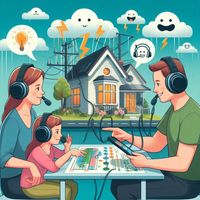Crisis Management Reimagined: How Multisensory Scenarios Empower Societies and Responders
Listening to act – How acoustic training can strengthen our resilience
Acoustic training is the key to building an important bridge to safety and resilience in potentially chaotic and noisy situations – because those who understand and internalize the sounds of danger remain capable of acting at the decisive moment. The future of emergency management should also focus on targeted sensory training as a tool for strengthening resilience and crisis management skills. Those who recognize the sounds of danger and have internalized them in a lasting way remain capable of acting. Because resilience often begins not with reaction, but with perception.
The future of effective emergency management also lies in targeted training of our senses—especially those that are most readily available in an emergency: hearing, sight, and touch.
Especially after the COVID-19 pandemic, which caused many people — including everyday heroes such as emergency responders — to lose some of their sense of smell and taste, we need to rethink our sensory balance. As an early warning system, hearing deserves more attention than ever before in crisis situations.
It happens time and time again: a sonic boom. A sudden, escalating noise during large demonstrations. An alarm that cannot be properly identified.
Such acoustic stimuli can trigger fear and panic – among emergency services personnel and the civilian population alike. What if we could experience and practice these sounds in advance without putting ourselves in real danger?
With virtual reality, tactile simulations, and multisensory scenarios, this is exactly what can be achieved: realistic experiences – without any threat. Because a purely theoretical understanding is often not enough. Newspaper articles explain the sonic boom – but the body reacts to what it feels, not to what it has read.
That's why we need practical, multisensory training
👉 For greater awareness
👉 For faster confidence in taking action
👉 For deeper resilience in dealing with extreme stimuli
Imagine if we could learn to regulate stress responses such as the release of adrenaline or cortisol in a more targeted way – while consciously promoting mental and physical strength.
This interplay between technology, science, and human responsiveness is not only possible, but urgently needed. It has the potential to become one of the most effective tools in civil and professional crisis preparedness — for a more sustainable sense of security and a more mindful society.
There are numerous examples of possible applications. In the next steps, I would like to highlight a few particularly relevant aspects — as inspiration, as an invitation, as a door to greater resilience.
The list of examples that come to mind would be very long, so I would like to specifically highlight and bring attention to a few key points.
Extraordinary sounds as part of an emergency management and citizen awareness training
Sonic booms – noise emissions and pressure waves from military jets or supersonic aircraft
This topic represents a delicate balancing act between technological innovation, military requirements and the protection of the population, animals and our environment.
- A sudden bang that feels like a heavy blow against the walls.
- Shaking of windows and glasses due to the pressure wave.
- The sensation of a "standing sound," as if the air itself were vibrating.
- Reverberating noises that gradually fade into the distance.
- Vibrations strong enough to knock books off shelves.
- Doors bursting open due to the air pressure.
- A muffled droning in the ears after the sound.
- A feeling of pressure on the chest.
- Perception that the ground might be lightly trembling.
- Difficulty pinpointing the origin of the sound.
The future will certainly bring a lot in this area and impressive innovations will conquer the market (especially in terms of noise emissions), be it the planned supersonic aircraft Comac C949, Nasa X-59, the AS2 business jet from Aerion or Boom Supersonic, a business jet that can fly at supersonic speed (SENECA project). (1) (2) (3)
The parallel promotion of resilience in an increasingly noise-sensitive (and unfortunately also chronically ill) society is essential. Noise-based regulations for supersonic flights over land must not only be comprehensively developed, but also designed with the health and psychological needs of the population in mind. These developments could not only increase the acceptance of such flights, but also significantly reduce the burden on noise-sensitive groups.
Explosions - from small detonations to larger explosions
In situations such as New Year's Eve, city festivals, festivals, but also in soccer stadiums where large crowds gather, these noises can also lead to fear and panic under certain circumstances. It is therefore crucial to prepare the civilian population for such acoustic scenarios through multisensory training. It is important to be able to distinguish between these sounds in order to react in a safe manner instead of falling into stress or chaos.
1. The sound of high-pitched noises from fireworks with a short, sharp bang. The mixture of sharp bangs and colorful visual effects can be overwhelming for many people, especially those with sensory sensitivities. On the other hand, bangs in quick succession, such as during a finale, can cause anxiety due to their intensity.
2. Deep, thunderous explosion noise. The reverberation of such noises, e.g. in open stadiums, can intensify and convey a feeling of massive threat. The reverberation of sounds can trigger a particularly frightening and oppressive mood and reaction and may lead to disorientation.
3. Shattering glass noises that follow immediately after the explosion. A possible frightening acoustic side effect in the event of accidents or malfunctions, e.g. caused by pyrotechnics. These noises could potentially trigger an escalation of panic in crowds.
4. Metallic crunching of destroyed vehicles or machines. Possible high relevance also at demos or events (can also be accompanied by explosions).
5. Echo of explosions in closed rooms. Beware of reverberation and unforeseen panic reactions.
6. Vibration of the ground or the building due to the pressure wave. The physical effect of these noises can reinforce the emotional impression and then be perceived as a massive signal of danger.
7. Sudden bursts of noise are particularly attention-grabbing and can increase stress levels enormously.
8. Be careful with changes in air pressure, as these can be felt in the ear and the pressure in the ear can make perception more difficult. Impaired auditory-visual perception can significantly increase disorientation or a feeling of helplessness. The pressure in the ear can not only cause dizziness, balance problems and even mild pain, but can also severely restrict the ability to act in emergency situations. If those affected do not understand the origin of the feeling of pressure, this can lead to anxiety and intensify the stress reaction.
9. Spark or flame noise from the explosion itself.
10. A dull roar that spreads through the surrounding area..
Multisensory training could, for example, simulate changes in air pressure so that those affected get used to them and consciously perceive their reactions and practise balancing the pressure. Equally important is the regular practice of controlled and even (calm) breathing in these situations to reduce stress levels. In high-risk areas, special earplugs are recommended to equalize or minimize the pressure.
A short wake-up call about the real dimension of those potentially affected, who need to be considered when planning in the area of “noise and its possible effects” and whose quality of life and safety could be greatly improved through targeted integration of their special needs in emergency management.
The number of people affected (which has been significantly increased by Covid 19 and has become a global problem) is enormous.
- Children (as they are particularly vulnerable to the effects of sudden and intense noises). The nervous system of children is not yet fully developed, which leads to increased sensitivity to sensory stimuli like noise. The result is fear and panic, as they do not always understand or recognize the source and meaning of the sound. Children with chronic or sensory conditions such as ADHD, Long Covid, autism spectrum disorders and others are even more susceptible to the negative effects of noise. Targeted training that teaches children and parents how to cope with noise, as well as the provision of child-friendly protective measures, could significantly contribute to fostering their resilience.
- orthostatic hypertension
- Tinnitus (Chronic tinnitus can impair sound processing and lead to increased sensitivity to loud or sudden noises)
- Anxiety disorders, depression (Soundscapes can trigger stress reactions in these individuals, intensifying their symptoms such as palpitations or shortness of breath)
- ADHD (Affected individuals often struggle to filter out irrelevant noises, leading to heightened sensitivity to acoustic stimuli)
- Post-traumatic stress disorder (PTSD): Sudden noises can trigger flashbacks or panic attacks
- Migraines
- Vestibular disorders or Meniere’s disease
- Cardiovascular diseases (Sudden noises can induce stress, raising blood pressure and increasing the risk of arrhythmias or angina pectoris)
- Epilepsy (Certain noises or sudden acoustic stimuli can trigger seizures in some affected individuals)
- Fibromyalgia (Often associated with increased sensory sensitivity, including heightened sensitivity to noise)
- Chronic fatigue syndrome (CFS/ME) / Long Covid (Noise can be perceived as overwhelming and exacerbate existing fatigue)
- Multiple sclerosis (MS): Loud or sudden noises can induce stress, worsening symptoms like muscle spasms or fatigue)
- Parkinson’s disease / dementia (Sudden noises can cause confusion and fear or exacerbate symptoms like trembling and stiffness)
- Chronic pain
- Fear of noise (Phonophobia)
- Chronic irritable bowel syndrome (IBS) (The disrupted communication between the gut and the brain makes people with IBS more susceptible to external stressors like noise, which could then influence neuronal activity in the gut and worsen symptoms)
- Schizophrenia (Loud or sudden noises can intensify hallucinations or paranoid thoughts)
- Sleep disorders (Noise can disturb sleep and exacerbate symptoms of insomnia or sleep apnea)
- Chronic skin conditions (e.g., psoriasis - stress induced by noise can exacerbate inflammatory processes in the body)
- Chronic kidney diseases (Soundscapes are an often overlooked factor that can significantly affect the health of people with chronic kidney diseases)
- Chronic respiratory diseases (e.g., COPD - stress caused by loud noises can exacerbate shortness of breath or panic attacks)
- Autism spectrum disorders (A sensory hypersensitivity to noises can lead to stress or overwhelm).
Sudden noises such as “explosions” activate the “fight-or-flight” response, which is controlled by the sympathetic nervous system and leads to a further increase in blood pressure, dizziness, palpitations, ringing in the ears, syncope or possibly even shortness of breath.
Exercises to stabilize the circulation, as recommended for orthostatic hypertension, could be integrated into such training to increase physical resilience. Through targeted training, those affected could then learn to control their stress reactions, which would significantly reduce the release of adrenaline and blood pressure spikes.
Why emergency management should act here?
The risk of injury, escalation and long-term negative effects on health increases dramatically if the needs and consequences of these groups are not sufficiently taken into account.
Training and awareness of the emergency services and the general public could enable those affected to control their reactions to background noise and protect themselves better.
Why mass protests should play a key role in emergency management and also in civil awareness training and why are these “scenarios” just as important for citizens as they are for our everyday heroes?
1. The dynamics of mass protests can (very) quickly shift from peaceful to violent. Emergency management must be able to respond to these changes immediately. BUT citizens must also be able to recognize the soundscape and dynamics of mass protests in order to react quickly and safely – especially since escalating situations often cause the greatest damage.
2. The soundscape, including chants, sirens and chaotic noises, is often an indicator of the mood of the crowd. Our everyday heroes/emergency forces must learn to interpret these many acoustic signals in order to take appropriate measures. Sound training could help prepare emergency forces for stressful acoustic environments and strengthen their resilience to emotional stress. If we learn to recognize critical sounds such as sirens, screams or breaking glass, we can better assess whether we are in a dangerous situation. This knowledge and ability help us to react early and get to safety before an escalation occurs.
3. Protests bring physical risks such as injuries, property damage and blockages, which are often heralded by the acoustic soundscape. Chaotic noises can be early signs of escalation. Emergency forces that quickly analyze sounds and combine them with visual signals can detect and prevent dangerous situations at an early stage. Citizens who are prepared for loud and chaotic soundscapes remain calmer and more capable of action. This prevents panic from making their behavior unpredictable.
4. The soundscape can be overwhelming for both the population and emergency forces. Stress reactions, such as the release of adrenaline and cortisol, can impair their decision-making abilities. Special resilience training (e.g., extremely loud and chaotic environments) could help regulate this stress and act calmly. Informed and trained citizens could then contribute to reducing "chaos" with targeted actions, such as orderly evacuations and avoiding dangerous areas. People who know how to protect themselves are less reliant on direct assistance from emergency forces, leading to a corresponding relief for them.
The risk of escalation and injuries could be massively reduced by preparing both the population and emergency services for soundscapes such as those at mass protests.
Multisensory training that combines visual and auditory elements could improve the operational capability and resilience of emergency services in the long term.
Scenario exercises of the background noise of a power outage - awareness and resilience
- A faint electrical hum that abruptly ceases when the power supply is interrupted.
- The sudden absence of background noises such as air conditioners, refrigerators, routers, modems, washing machines, dishwashers, televisions, audio devices in standby mode, aquarium pumps, smart home devices, cooling and freezing appliances, electric blinds and shutters, pumps of heating circuits, air conditioning systems, laptops ... creates an oppressive silence. Without the typical background noises, one's own breathing or footsteps appear louder and much more present. This can also evoke a sense of isolation and fear. Sensitivity to noise is significantly heightened, meaning that sudden noises, like the slamming of doors or falling objects, are perceived more intensely, which can lead to startled reactions. Everyone knows that silence and darkness can mutually amplify each other, which in turn can create an atmosphere where even faint sounds are perceived as eerie or threatening.
- The absence of the constant hum of devices can metaphorically be perceived as stagnation, which could trigger a feeling of loss of control. Alarm systems or security devices that no longer make any sounds during the blackout can reinforce the feeling of loss of protection.
- Silence can evoke fears, memories and emotions that are normally overshadowed by the daily acoustic environment.
- A faint cracking and rustling of electrical wiring can be heard before the complete failure. Pets might react to the altered soundscape by becoming either restless or unusually quiet – this could further unsettle and confuse their owners.
- A decreasing, deep hum or buzz as machines or devices slow down and eventually stop working.
- The typical sound when fuses blow or electrical systems shut down.
- Noises from uninterruptible power supplies (UPS) or smoke detectors indicating the outage.
- A distinct sound of relays or switches in large electrical systems when switching or shutting down.
- Devices like generators and fans produce audible vibrations that abruptly stop when the power goes out.
- In large spaces, the sudden silence is amplified, creating a noticeable change in the acoustic environment.
- Occasional hissing or cracking sounds when electrical systems release residual voltage.
- The activation of emergency generators is often associated with loud rattling or humming noises.
- Darkness after a power outage can lead to objects being accidentally knocked over, posing significant risks as limited visibility often results in unintended errors. Here, I think of obstacles like shoes, bags, backpacks, toys, furniture edges, water or feeding bowls for pets, umbrellas, pets, shopping bags and packages, tools, vacuum cleaners, books, extension and charging cables, power strips, etc., which are overlooked on the floor, leading to trips and falls.
- We often move more cautiously in the dark, amplifying the sound of footsteps and quiet conversations, which could intensify fears or insecurity.
- Without the usual electrical background noises, natural sounds like wind and rain are perceived much more distinctly. The sudden accentuation of noises, such as a strong whistling wind, might be overwhelming as one has to focus on an acoustic dimension that is not typically in the foreground.
- Without electrical noises, often associated with daily routines and activities, a surreal atmosphere can arise, possibly evoking a "dangerous" sense of uncertainty.
- Sudden, random sounds, such as the slamming of doors, creaking floorboards, dripping faucets, rattling shutters, rustling of clothing, scratching noises from pets, fluttering curtains or tarpaulins, the sound of objects falling, are then perceived much more intensely as the silence amplifies them. A dripping faucet can become a constant and intense disturbing noise in the silence.
Targeted publicity campaigns should also be pursued in the area of “acoustic perception”
The integration of noise as an additional central aspect in emergency campaigns could not only strengthen the resilience of the population, but also improve the effectiveness of protective measures. Noise prevention campaigns often only look at everyday noise pollution such as road traffic or neighborhood noise and rarely address acoustic challenges such as extreme weather events (loud howling wind or flying debris).
In order to prepare the population for the acoustic challenges of tornadoes and storms, targeted public campaigns and scenario training could also make a significant contribution to resilience and safety. The noise associated with such natural disasters - e.g. strong howling winds, breaking branches, flying debris - is often underestimated, although it can lead to panic, disorientation and psychological stress.
Why would this make sense?
- If we know what to “expect” and how to deal with acoustic stimuli, many people feel safer and react in a more controlled manner.
- Education about specific noises can help to avoid panic and make the right decisions, e.g. to seek shelter and remain calm.
- The population will be even better prepared to understand emergency signals and instructions despite high noise levels.
Possible potential content for a campaign
- "What does the noise tell us?” An explanation of which noises are typical warning signals of danger.
- "What does safety sound like?” An explanation of how emergency alarms and announcements can be perceived and interpreted despite the noise.
- "Noise protection for everyone” A distribution of earmuffs and possible other aids, combined with an explanation of their benefits.
- "Calm in chaos” Practicing techniques for coping with stress in noisy emergency situations.
- "Noise training for everyday life” Offers for people who are sensitive to noise to further strengthen their resilience.
This contribution was written by Birgit Bortoluzzi, the creative founder of the “University of Hope” – an independent knowledge platform dedicated to resilience, education, and compassion in a complex world.
Sources:
(1) https://www.scmp.com/news/china/science/article/3304082/comac-c949-china-unveils-quiet-supersonic-jet-50-longer-range-concorde (Retrieval: 12.04.2025)
(2) https://www.luftfahrtmagazin.de/luftfahrt/flugzeuge/ueberschallflugzeuge-das-bringt-die-zukunft-ab-2025-221553.html (Retrieval: 12.04.2025)
(3) https://www.aerointernational.de/aviation-nachrichten/nasa-x-59-leiser-ueberschall-luftverkehr.html (Retrieval: 12.04.2025)







